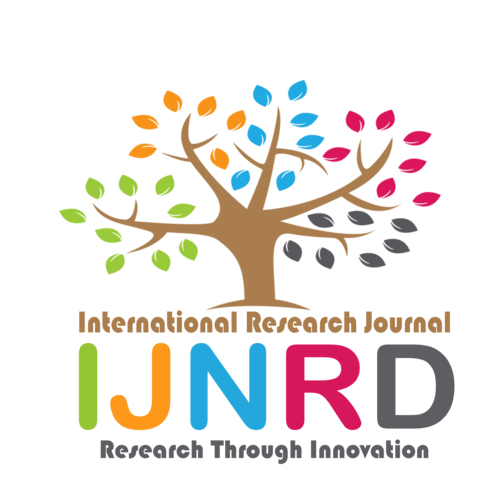|
|||||||||||||||

|
INTERNATIONAL JOURNAL OF NOVEL RESEARCH AND DEVELOPMENT International Peer Reviewed & Refereed Journals, Open Access Journal ISSN Approved Journal No: 2456-4184 | Impact factor: 8.76 | ESTD Year: 2016 Scholarly open access journals, Peer-reviewed, and Refereed Journals, Impact factor 8.76 (Calculate by google scholar and Semantic Scholar | AI-Powered Research Tool) , Multidisciplinary, Monthly, Indexing in all major database & Metadata, Citation Generator, Digital Object Identifier(DOI) |
||||||||||||||
Issue: April 2024
Volume 9 | Issue 4
Review Result and Publication of Paper within : 2-3 days
Click Here For more DetailsFor Authors
Forms / Download
Published Issue Details
Editorial Board
Other IMP Links
Facts & Figure
Impact Factor : 8.76
Issue per Year : 12
Volume Published : 9
Issue Published : 95
Article Submitted :
Article Published :
Total Authors :
Total Reviewer :
Total Countries :
Indexing Partner
Join RMS/Earn 300
Licence
This work is licensed under a Creative Commons Attribution-NonCommercial 4.0 International License







|
Published Paper Details
|
|
| Paper Title: | Determining of the river run-off and developing of the control methodology using the example of existing energy purpose water reservoirs |
| Authors Name: | khatia chokheli , Grigol Khelidze |
| Download E-Certificate: | Download |
| Author Reg. ID: |
IJNRD_181059
|
| Published Paper Id: | IJNRD2204098 |
| Published In: | Volume 7 Issue 4, April-2022 |
| DOI: | |
| Abstract: | Abstract Georgia occupies an important place in the world with medium height of fresh water formed within one year. Excess of atmospheric precipitations, especially in the Black sea region, and mountainous landscape provides ideal conditions for that. For territorial distribution of water resources and water management it is important to use water reservoir efficiently. With water balance method it is possible to determine the amount of incoming, outgoing and accumulated water in the water reservoir. Reservoirs are mainly multipurpose waterbody. They are used for hydroelectric power plants, irrigation canals and water supply systems, which are used to generation, irrigation, water supply and etc. For any reservoir to use water resources efficiently according to its intended purpose it is necessary to plan and use effectively existing water resources. For this it is necessary to determine the amount of water resources for certain periods of time. It is for this purpose the amount of river runoff (actual and forecast) inflowing into the reservoirs during different periods of the year needs to be determined. The principle of water balance is violated under conditions of sharp anthropogenic interference in natural processes. Such interference results in a measure of change in the elements of the balance, which is reflected in the content of the balance equation. Creating the water balance equation is a complex task because the accuracy of water balance equation depends not only on knowledge and available factual information, but also depends on the particular purpose and practical task which must be achieved by the equation of balance. Additionally, the equation of balance is often used to determine an unknown element of the equation. The article discusses the importance of balance studies under existing conditions and the practical side of their use using the example of the existing energy purpose reservoir in Georgia - Shaori Reservoir and Tkibuli Reservoir. The article presents the method of determining the most important element of water balance - river runoff under specific conditions where water inflow into the reservoir cannot be gauged. Specific conditions may include: 1) temporary cessation of the operation of water gauge (hydrometric station); or 2) impossibility to install a hydrometric station due to natural conditions such as the existence of karst lakes or when the river bed is completely covered by the reservoir and the river is engulfed by it. Research of the elements of the balance takes into consideration anthropogenic factors, and uses factual information. |
| Keywords: | Keywords: Water balance; Water resources; Energy purpose reservoir; River runoff; Water inflow. |
| Cite Article: | "Determining of the river run-off and developing of the control methodology using the example of existing energy purpose water reservoirs", International Journal of Novel Research and Development (www.ijnrd.org), ISSN:2456-4184, Vol.7, Issue 4, page no.808-817, April-2022, Available :http://www.ijnrd.org/papers/IJNRD2204098.pdf |
| Downloads: | 000118763 |
| ISSN: |
2456-4184 | IMPACT FACTOR: 8.76 Calculated By Google Scholar| ESTD YEAR: 2016 An International Scholarly Open Access Journal, Peer-Reviewed, Refereed Journal Impact Factor 8.76 Calculate by Google Scholar and Semantic Scholar | AI-Powered Research Tool, Multidisciplinary, Monthly, Multilanguage Journal Indexing in All Major Database & Metadata, Citation Generator |
| Publication Details: |
Published Paper ID:IJNRD2204098 Registration ID: 181059 Published In: Volume 7 Issue 4, April-2022 DOI (Digital Object Identifier): Page No: 808-817 Country: Tbilisi, Georgia, Georgia Research Area: Water Resourses & Management Publisher : IJ Publication Published Paper URL : https://www.ijnrd.org/viewpaperforall?paper=IJNRD2204098 Published Paper PDF: https://www.ijnrd.org/papers/IJNRD2204098 |
| Share Article: | |
|
Click Here to Download This Article |
|
| Article Preview | |
|
|
|
Major Indexing from www.ijnrd.org
| Semantic Scholar | Microsaoft Academic | ORCID | Zenodo |
| Google Scholar | ResearcherID Thomson Reuters | Mendeley : reference manager | Academia.edu |
| arXiv.org : cornell university library | Research Gate | CiteSeerX | PUBLON |
| DRJI | SSRN | Scribd | DocStoc |
ISSN Details
 |
 |
ISSN: 2456-4184
Impact Factor: 8.76 and ISSN APPROVED
Journal Starting Year (ESTD) : 2016
DOI (A digital object identifier)
Conference
Open Access License Policy
Important Details
Social Media
| Copyright © 2024 - All Rights Reserved - IJNRD |












Facebook Twitter Instagram LinkedIn